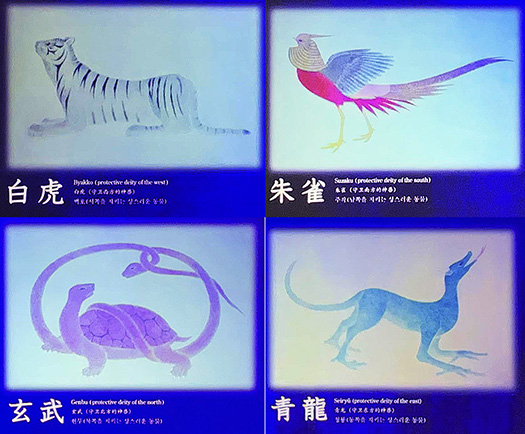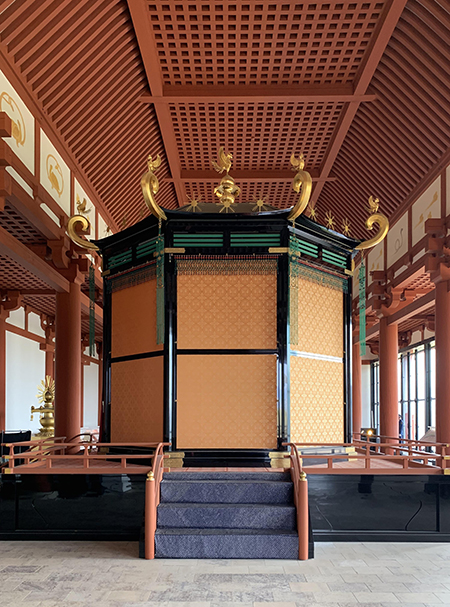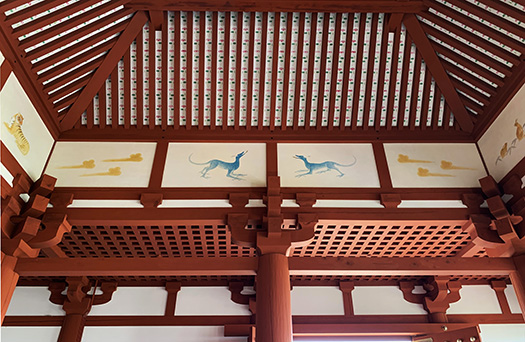


わたしが高校生の頃に修学旅行で訪れた「奈良の都」とは、
シカが群集まってくる東大寺南大門〜大仏殿建築が主役。
いまの奈良市役所周辺の地域でしたが、創建時の平城京にとって
このいまの「中心地」は外京エリアであって、
本当の首都機能中心地域はいま復元されつつある平城京公園地域。
今後、この大極殿や朱雀門などの地域が修学旅行の目的地のひとつになるのか。
こういう探究型の変化はたいへん有意義で面白いと思う。
なんだけれど、青少年たちが東大寺大仏殿を同様に、
この復元平城宮大極殿を「日本らしさ」と受け取ることについては
どうなのか、とは思う部分がある。
普遍性のある世界宗教としての仏教を日本が受容したことは自明だけれど、
一方で中華思想に基づく建築である大極殿は必ずしもそう思えない。
三内丸山とか古代出雲神殿などの方をこそ日本建築の初源知識とすべきかと。
歴史的経緯としてはじめて「統一国家」としてのカタチを整えていく時期に
日本は国家政体としてのモデルを中華思想に求めたに過ぎず、
それが世界標準のありようだと認定して限定的に受容したのが実態と思う。
まぁ相対的認識を得るために他の京都建築なども見学するのだから、
そう目くじらを立てるほどとも思わないけれど・・・。
そして実際の日本史は非中華の方向、より民主的方向に向かった。
で、統一国家形成の経緯を表しているのが中華思想的「四神」の祀られよう。
写真は復元平城宮大極殿の小壁に描かれたかわいい動物画。
奈良県に在住の日本画家・上村淳之(あつし)氏の描画によるもの。
西が白虎、東が青龍、南が朱雀で北が玄武。それぞれの方位に描かれている。
絵を見て面白かったのが青龍であります。
わたしの干支でもありますが、想像上の動物なので
「え、こういうのが龍なの?」という驚きを持ってしげしげと見た。
普通、寺院などの天井画に描かれている龍はもっとヘビっぽくて
表情もおどろおどろしい。こちらの青龍はどうもイヌかシカっぽい。
ここまで「かわいい」印象の龍を見るのは新鮮な感覚。
復元に当たってこういう「壁画」の根拠証拠を求めただろうけれど、
たぶん消失して記録もないのだろうと推測できる。
そこであまり権威主義的ではない表現を目指してこういう画風選択に至ったのか。
結果としてわたし的には納得感があった。
このやさしさ感は日本的な印象を与えてもくれると思った。

そういう印象をさらに高めていたのが、一見タイベックシートの図案と見えた(笑)
天井のデザイン図案。
これもやさしげな日本画的な模様が表装されていた。
復元に当たってのデザイン方針としてハードな「中華思想」感をやわらげ、
和風の威信建築というコンセプトだったように感じられた。
そのことには同意したい気分を持った次第です。
English version⬇
Heijo Palace Daigokuden “Four Deities and Twelve Zodiac Signs” Nara, Heijo-kyo: Searching for the Heijo-kyo Capital-20
A group of Japanese paintings that give a more Japanese impression of the hard authoritarianism of Chinese thought. The four gentle deities heal us (smile). …
The “capital of Nara,” which I visited on a school excursion when I was a high school student, is a city of the Nara Period.
The “Nara Capital” that I visited on a school excursion when I was a high school student was the area around Todaiji’s South Gate and the Daibutsuden (Great Buddha Hall), where deer gather in large groups.
The area around the present-day Nara City Hall was the center of the Heijo-kyo Capital at the time of its foundation, but this area was not the center of the capital at the time of its foundation.
The real center of the capital was the area of the outer capital.
The true center of the capital’s functions is the Heijo-kyo Park area, which is now being restored.
Will the Daigoku-den and Suzakumon be one of the destinations for school excursions in the future?
This type of exploratory change would be very meaningful and interesting.
However, I am not sure whether young people will accept the Todaiji Daibutsuden as “very Japanese” or not.
I wonder about the possibility that young people will accept the restored Heijo Palace Daigoku-den as “Japaneseness”.
I wonder about the possibility that young people will accept the restored Heijo Palace Daigoku-den as “Japaneseness.
It is obvious that Buddhism was accepted as a universal world religion.
On the other hand, Daigoku-den, an architecture based on Chinese thought, does not necessarily seem to be so.
Sannai-Maruyama and the ancient Izumo Temple should be regarded as the first source of knowledge of Japanese architecture.
Historically, it was the first time for a unified nation to take shape.
The model for a national polity was based on Chinese ideology, and this was recognized as the global standard.
The reality is that they recognized it as the world standard and accepted it as such.
Well, since we visit other architectures in Kyoto in order to gain a relative understanding, I don’t think it’s so much of a big deal.
I don’t think it is worth making such a big deal out of it.
And actual Japanese history took a non-Chinese direction, a more democratic direction.
And so, the process of forming a unified nation is represented by the Chinese ideological “Four Gods” enshrined.
The photo shows a cute animal painting on a small wall of the restored Daigoku-den Hall of Heijo Palace.
It was painted by Atsushi Uemura, a Japanese-style painter living in Nara Prefecture.
The white tiger is on the west, the blue dragon on the east, the red bird on the south, and the black turtle on the north. Each of them is depicted in its own direction.
When I saw the painting, I was interested in the blue dragon, which is also my zodiac sign.
It is also my zodiac sign, but it is an imaginary animal.
I looked at it with surprise, “Oh, this is a dragon?” I looked at it with surprise.
Usually, dragons depicted in ceiling paintings of temples and other places look more like snakes.
and their expressions are frightening. This blue dragon looks like a dog or a deer.
It was a new experience for me to see such a “cute” dragon.
I suppose they would have asked for evidence of this kind of “wall painting” when they restored it.
However, we can assume that it has probably disappeared and there is no record of it.
I wonder if this style of painting was chosen in order to create a less authoritarian expression.
As a result, I was satisfied with the result.
This sense of gentleness also gives me a Japanese impression.
Such an impression was further enhanced by what appeared at first glance to be a Tyvek sheet design (laugh).
The design of the ceiling.
It was also covered with a gentle Japanese painting-like pattern.
The design policy for the restoration of the building was to soften the hard “Chinese idea” and to create a prestige building in a Japanese style.
I felt that the design policy in restoring the building was to soften the hard “Chinese idea” and create a prestige building in a Japanese style.
I was inclined to agree with this.
Posted on 5月 6th, 2022 by 三木 奎吾
Filed under: 住宅マーケティング, 日本社会・文化研究







コメントを投稿
「※誹謗中傷や、悪意のある書き込み、営利目的などのコメントを防ぐために、投稿された全てのコメントは一時的に保留されますのでご了承ください。」
You must be logged in to post a comment.